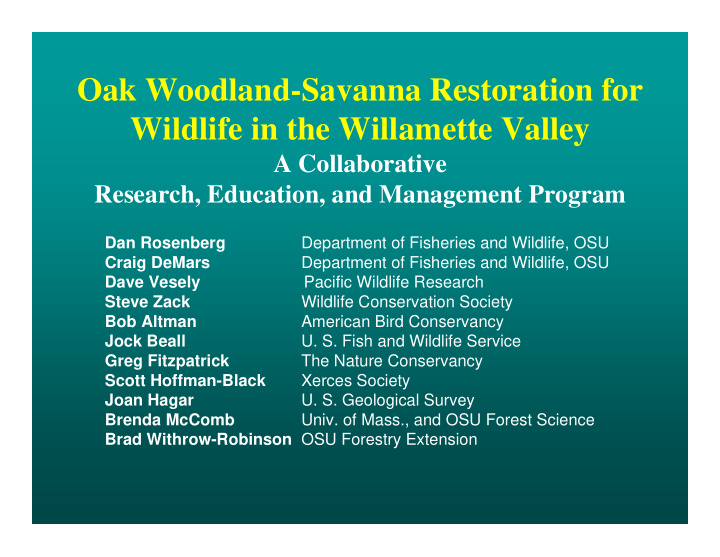



Oak Woodland-Savanna Restoration for Wildlife in the Willamette Valley A Collaborative Research, Education, and Management Program Dan Rosenberg Department of Fisheries and Wildlife, OSU Craig DeMars Department of Fisheries and Wildlife, OSU Dave Vesely Pacific Wildlife Research Steve Zack Wildlife Conservation Society Bob Altman American Bird Conservancy Jock Beall U. S. Fish and Wildlife Service Greg Fitzpatrick The Nature Conservancy Scott Hoffman-Black Xerces Society Joan Hagar U. S. Geological Survey Brenda McComb Univ. of Mass., and OSU Forest Science Brad Withrow-Robinson OSU Forestry Extension
Presentation Goals • highlight imperiled status of Oregon Oak habitats • identify research and monitoring needs • discuss challenges in monitoring and research • introduce research and education program • discussion on future directions
Oregon Oak Woodland and Savanna Plant Communities in the Willamette Valley Origin
Oregon Oak Woodland and Savanna Plant Communities in the Willamette Valley
Oregon Oak Woodland and Savanna Plant Communities in the Willamette Valley Change in Condition
Oregon Oak Woodland and Savanna Plant Communities in the Willamette Valley Restoration
Wildlife Conservation is a Key Goal of Restoration Efforts “ This project will benefit both at-risk animal species…acorn woodpecker, Lewis’ woodpecker, western meadowlark, and Fender’s blue butterfly… ”
Our Premise: Conservation of wildlife, from butterflies to birds, is a key goal of oak woodland–savanna restoration • little is known of wildlife response • nor how this affects wildlife in other habitats • “indicators” of successful restoration • guide restoration particularly those larger-scale
Oak Woodland-Savanna Restoration for Wildlife in the Willamette Valley A Collaborative Research, Education, and Management Program Goal: Conserve and restore wildlife and their Oak Woodlands–Savanna habitats in the Willamette Valley through an integrated collaborative research, education, and management program
Guiding Questions How do different conservation strategies affect wildlife at the landscape scale?
Guiding Questions What are the tradeoffs for wildlife with various management prescriptions?
Guiding Questions What are the most efficient approaches for monitoring restoration success ?
Guiding Questions What are the most efficient and informative approaches for monitoring restoration success ?
Guiding Questions What educational efforts are needed to make conservation effective? And discussion among researchers, restoration ecologists, plant and wildlife ecologists…..
Thoughts on Research Needs Autecology Lewis’s Woodpecker Broad survey of invertebrate habitat associations 5000 species associated with California oak woodlands
Thoughts on Research Needs Effects of Restoration Practices Unintended Impacts Assessment of Assumed Positive Responses
Thoughts on Research Needs Evaluation of Thresholds and Surrogates: Cost efficiency Cost/benefit high Cost/benefit low Wildlife Response Restoration Success Metric (e.g., percent native vegetation)
Thoughts on Research Needs Landscape Scale Responses A modeling approach • link with existing efforts at the stand scale • link with previous work at the Valley scale • link with conservation efforts
Thoughts on Research Needs Landscape Scale Responses Empirical evaluation of landscapes and wildlife associations • meshing fine scale mechanistic studies with hypotheses on response to landscape pattern
Three basic kinds of restoration in oak woodland- savanna habitats 1)Structural Restoration: converting “closed form” oak woodlands to open stands of large, “open-form” oaks 2) Compositional Restoration: restoring oak woodland-savanna plant communities 3) Restoration of scale: restoring large areas of oak-woodland savanna
Structural and Compositional Restoration Possible Wildlife “Indicators”: Fender’s Blue Butterfly White-breasted Nuthatch Western Gray Squirrel Dense stands of Open stands of large Oaks; oak, or oak and “open-form oaks” Douglas-fir; “closed-form oaks” (acorns, cavities, vertical stratification, under-story)
Restoration of Scale Possible Wildlife “Indicators”: Acorn Woodpecker Lewis’ Woodpecker Western Gray Squirrel Expand area under restoration Restore several adjacent properties
Start-Up Projects Role of Legacy Trees and Remnant Patches
Start-Up Projects Role of Legacy Trees and Remnant Patches Wildlife Value • Percent oak habitat in landscape • Under-story biomass/diversity
Start-Up Projects Jefferson Farm Monitoring Wildlife Response to Restoration 10 ha
Start-Up Projects Jefferson Farm Monitoring Wildlife Response to Restoration
Start-Up Projects Jefferson Farm Monitoring Wildlife Response to Restoration
Start-Up Projects Jefferson Farm Monitoring Wildlife Response to Restoration
Start-Up Projects Jefferson Farm Monitoring Wildlife Response to Restoration
Start-Up Projects Jefferson Farm Monitoring Wildlife Response to Restoration Nuthatch 10 ha
Start-Up Projects Jefferson Farm Monitoring Wildlife Response to Restoration Landscape Scale
Conservation Can Not Be Effective If People Don’t Appreciate the Resource Importance of linking research, education, and management
Recommend
More recommend